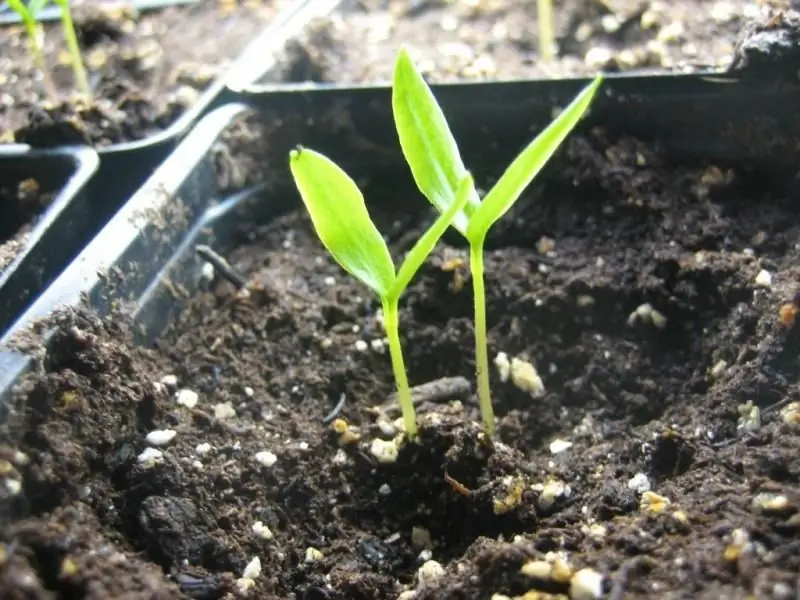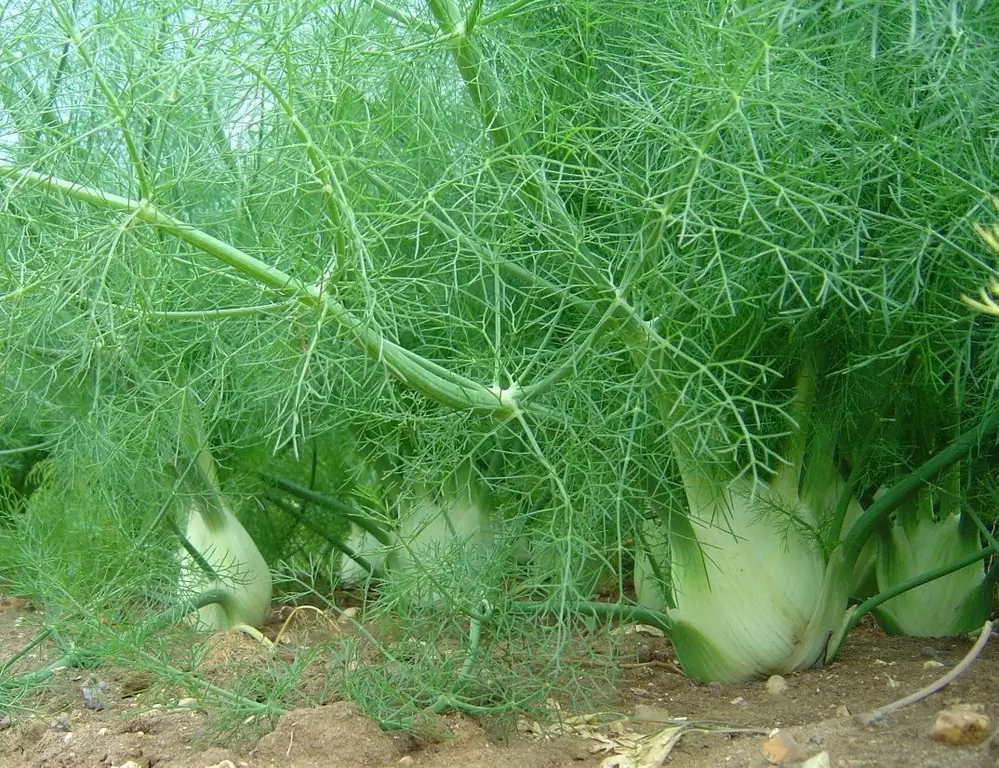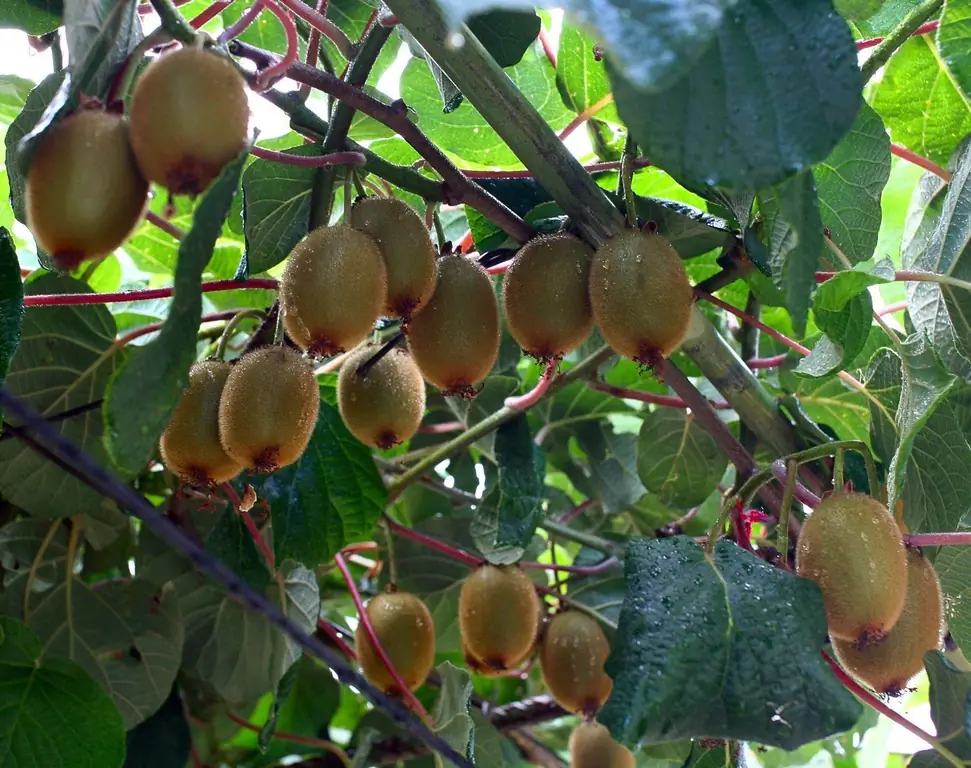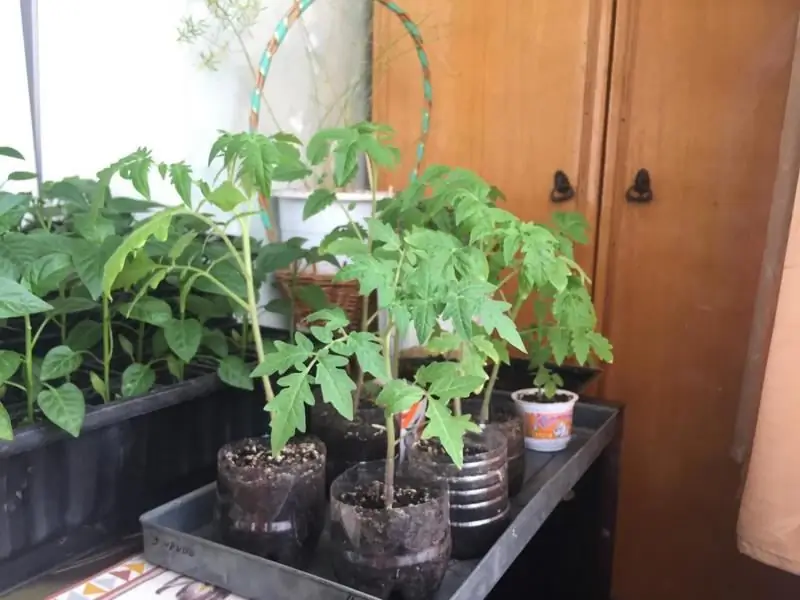
Table of contents:
- Under what conditions do tomato seeds sprout and how to care for seedlings
- How to check the germination of tomato seeds
- How to increase germination
- Effect of temperature on germination time
- Why seeds tested for germination do not germinate
- How to care for tomato seedlings
- Why tomato seedlings are dying
- Author Bailey Albertson [email protected].
- Public 2023-12-17 12:53.
- Last modified 2025-06-01 07:32.
Under what conditions do tomato seeds sprout and how to care for seedlings

Do you have any doubts about tomato seeds? Perhaps you collected them yourself, borrowed them from friends, or they are purchased with an expired shelf life. Not knowing how high-quality and viable the seeds are, it is difficult to determine their quantity for sowing. A simple check will solve the problem. You yourself can find out the germination of seeds, and in addition, accelerate their germination.
Content
- 1 How to check the germination of tomato seeds
-
2 How to increase germination
2.1 Video: vitamin cocktail to increase germination
-
3 Influence of temperature on germination time
3.1 Table: germination rate of tomato seeds at different temperatures
-
4 Why seeds tested for germination do not germinate
4.1 Video: 10 reasons why seedlings may not appear
-
5 How to care for tomato seedlings
5.1 Video: caring for tomatoes from germination to picking
- 6 Why tomato seedlings die
How to check the germination of tomato seeds
If you bought seeds from a well-known company (Gavrish, Aelita, Biotekhnika, Semko), they are fresh, perhaps even coated with fungicides and stimulants, then you do not need to check them. The germination rate of such seeds is always high - about 90%, that is, out of 20 seeds, 1-2 will not sprout. In all other cases, doubts may arise. And in order not to face the problem of poor germination of seeds in the spring, check them before sowing.
There are two main ways to test seeds for germination:
-
Immersion in various aqueous solutions. The most common is saline. Dissolve a tablespoon with a heap of salt in a liter of water. Dip the seeds into this water, stir and wait 5-7 minutes. Full-fledged ones will drown, while empty ones with dried contents will remain afloat. According to another version, potassium permanganate crystals are dissolved in water (1 g per 1 liter of water). But all the same happens in clean water, only you need to hold the seeds in it longer - up to 20 minutes.

Checking seeds for germination In water, full-weight seeds drown, empty ones remain on the surface
-
Germination in a humid environment. If there are a lot of seeds, you do not feel sorry for them, then in advance, even in winter, you can take a part and germinate on cotton pads or in a rag. Calculate the germination rate based on the results. For example, you took 20 seeds, sprouts appeared in 10, which means that the germination rate is 50%. When the deadline comes, sow twice as much as planned. If not a single seed has sprouted, then everything needs to be thrown away and new ones bought.

Germinating seeds If you have a lot of extra seeds, germinate a part in advance and calculate the percentage of germination
How to increase germination
An increase in germination is understood as stimulating germination, seedlings appear faster. There are ways to wake up even old seeds that normally do not germinate.
Method "Living and dead water" for old seeds:
- Pour the seeds onto a rag, pull off the edges with a thread to make a bag on a string.
- Submerge the seeds alternately in hot (80 ° C), then in ice water, for example, spring water or plain water with ice cubes. In each vessel, keep the bag for no longer than 5 seconds, then take it out, squeeze the water and lower it into another.
- Repeat 5 times, finish with cold water.

Place the bag of seeds in containers with hot and cold water one by one
Recipes for different solutions to accelerate seed germination:
- Epin - 2 drops per 100 ml of water.
- Energen Aqua - 1 ml or 9 drops per 50 ml of water.
- Sodium humate - 0.5 g per 1 liter of water.
- Bud - 2 g per 2 liters of water.
- Wood ash - 3 tbsp. l. stir in a liter of water, leave for 24 hours, drain.
- Aloe juice in its pure form for expired seeds, and for ordinary seeds, you can dilute it with water 1: 1.
Keep the seeds in any solution from 1 hour to 18. The older they are, the longer the stimulant treatment should be. However, you cannot leave seeds in water for a day or more! There is a supply of air under the seed coat, which is gradually consumed, the embryo dies.
Video: vitamin cocktail to increase germination
Effect of temperature on germination time
Optimum temperature for germination of tomato seeds: + 20… + 25 ° C, maximum +30 ° C. At +10 ° C and below, seedlings may not appear. Therefore, do not keep the boxes with crops on the windowsill, transfer them to a warm place. It can be found near the radiator, behind the refrigerator, in a hanging kitchen cabinet, in an unnecessarily standing incubator or on a heating pad.
Table: germination rate of tomato seeds at different temperatures
| Temperature (° C) | How many days will seedlings appear |
| + 12 … +15 | 15-17 |
| + 18 … +19 | 8-9 |
| + 22 … +25 | 4-6 |
Why seeds tested for germination do not germinate
In addition to a favorable temperature, moisture and breathable soil are needed for the emergence of seedlings. Also, seeds may not germinate if you sow them too deep.
Mistakes that prevent the seeds from sprouting, how to prevent or correct them:
- Sowed in poorly moistened soil or it dried out during germination, covered with a crust. Dig up a few seeds, if the seedlings have not yet appeared on them, then water, cover the crops with film or glass so that the earth does not dry out anymore, and wait for the shoots to appear. If you dug up and saw that the seedlings appeared, but dried up or rotted, then sow the tomatoes again.
- The earth was flooded, turned into mud. The seeds, being in such conditions for several days, most likely suffocated and rotted. Re-sow in loose, damp soil. The container with crops must have drainage holes to drain excess water.
- They deeply deepened. Sow tomato seeds to a depth of 1 cm. If you think that tomatoes do not sprout for this reason, then try to get to 1-2 seeds, gradually raking the soil to the side. Check: at what depth they are, if there are seedlings. If the seedlings are already making their way to the light, then loosen the top 2-3 mm of the soil to help them overcome the border and wait. In the worst case, you can find seeds without sprouts, covered with mold, then you need to reseed.
Video: 10 reasons why seedlings may not appear
How to care for tomato seedlings
Transfer the appeared sprouts to the lightest, but coolest window. To prevent seedlings from stretching out, a certain temperature regime is needed:
- the first 4 days: during the day + 12 … +15 ° C, at night + 9 … +12 ° C;
- from the 5th day until the end of cultivation: during the day + 23 … +25 ° C, at night + 12 … +14 ° C.
You can create coolness by protecting the window sill from the room with a thick curtain or film stretched over the window opening. Adjust the temperature with a vent. In addition, the boxes with seedlings must be turned to the glass with the other side every day so that the tomatoes do not grow lopsided. As for daylight hours, during the seedling period it should last at least 12 hours, if necessary, provide additional lighting.
Water the seedlings, not allowing even the top layer of the earth to dry out, that is, you need to constantly moisten it. To do this, use only settled water at room temperature. Pour it into the aisles, being careful not to hit the stems and leaves. Many gardeners water during this period not from a watering can, but from a syringe or syringe without a needle.

The syringe moistens the surface with water drops, which is necessary only for the emerging tomato seedlings
Often, tomato seedlings cannot shed the seed coat, they stand with it on the top instead of leaves. Put a drop of water on this shell, and after 1-2 minutes, remove by gently pulling on it. Do not pull forcefully or squeeze the seed, if it does not come off, moisten it again, wait and try again.
Every year, several tomatoes sprout with seeds on my "head". I tried to shoot this way, but always forgot to come up in a minute. As a result, the water dried up, the seed hardened again, I had to wet it again, and again I forgot to come up on time. But over time, I noticed that such repeated wetting also helps, the leaves from the inside, of course, tend outward, and when the shell is soaked, they succeed, albeit not the first time. Therefore, now I just come up when I remember and wet such heads, and then the tomatoes themselves show their strength.
When the first 1-2 true leaves appear on the tomatoes, plant them in individual pots, deepening to the cotyledons. Carry out further care as for ordinary seedlings: watering, feeding and planting in the ground, when the heat is established, without frost. They are usually planted in a greenhouse 2-3 weeks earlier.
Video: caring for tomatoes from germination to picking
Why tomato seedlings are dying
At seedlings, the roots are still very small, as soon as the top layer of the earth dries up, and they lose their vitality. It is necessary that the earth is always moist. But another problem arises from dampness - a black leg disease, from which tomatoes also die.

At the base, the stalk has become thin and blackened - these are signs of a black leg
To prevent seedlings from getting sick:
- Disinfect the seeds before sowing in a purple solution of potassium permanganate (1 g per 1 liter of water) or 3% hydrogen peroxide.
- Disinfect the ground by heating it to 100 ° C.
- After each watering, ventilate the room with seedlings: open a window or window. If it's cold outside, turn on the fan. There should be no stagnant air at the surface of the earth.
- Powder the ground once a week with ash or crushed coal.
- Sometimes add Fitosporin (1 tablespoon of concentrate per 10 liters of water) or potassium permanganate to the irrigation water until pink in color.
If the tomatoes are already sick, then they cannot be saved. Remove the sick from the common box, spill the earth with a solution of potassium permanganate or sprinkle with ash. But it is better to transplant the remaining seedlings into another container with fresh disinfected soil.
In order not to waste time in spring, check the germination of tomato seeds in advance. Expired can be revived with growth stimulants or contrast soaking. For successful germination, the seeds need to provide the desired temperature, humidity and oxygen access. The emerging seedlings will need care: watering, lighting, protection from diseases, picking.
Recommended:
Growing Fennel From Seeds (including Vegetable Seeds) At Home And In The Garden + Photo And Video

Practical tips for growing fennel from seed. Fennel species, varieties suitable for growing in the middle lane
How To Grow Kiwi (at Home From Seeds, Seeds, Etc.) + Video And Photos

Step by step instructions for growing kiwi at home. Growing from seeds and seeds, taking care of seedlings and plants during the growth period
Growing Potatoes From Seeds, Planting Seedlings

How to collect potato seeds and prepare them? Features of growing and care. Planting seedlings in open ground. Harvesting and storage
How To Grow Corn In The Country From Seeds Or Through Seedlings: When To Plant, How To Care And Other Features

Corn, features of its cultivation by seeds and seedlings, instructions for planting and care. List of popular varieties. Features for different regions. Video
Fertilizers For Seedlings Of Tomatoes And Peppers: Store And Home Dressings

General rules for feeding tomatoes and peppers, recommendations for the frequency of fertilization. Popular store fertilizers used by folk remedies
